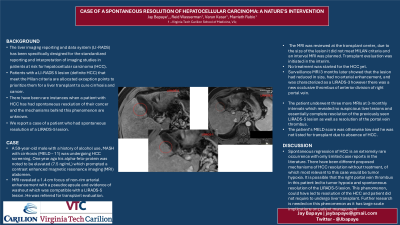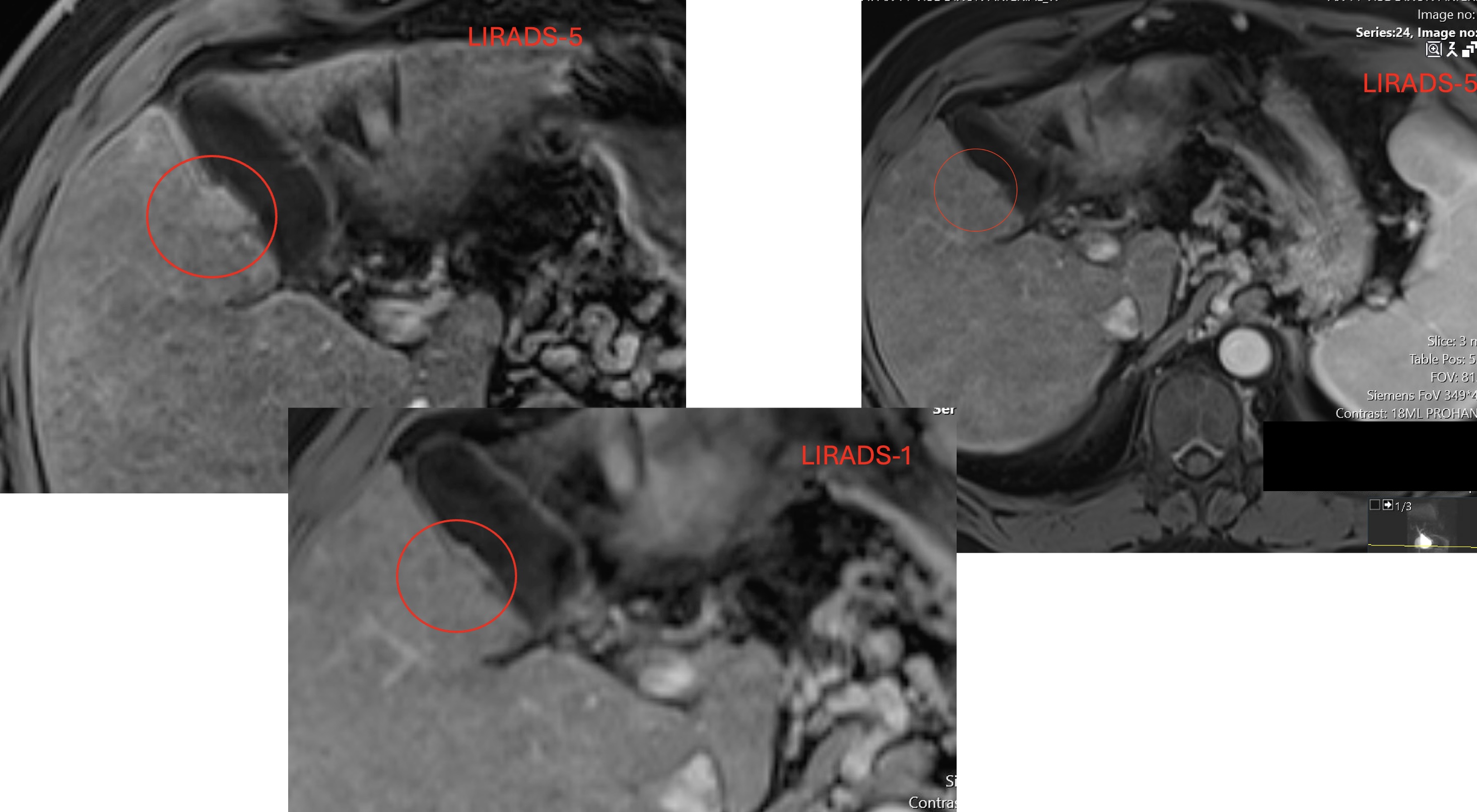Monday Poster Session
Category: Liver
P3039 - Case of a Spontaneous Resolution of Hepatocellular Carcinoma: A Nature's Intervention
Monday, October 28, 2024
10:30 AM - 4:00 PM ET
Location: Exhibit Hall E


Jay Bapaye, MD
Virginia Tech Carilion School of Medicine
Roanoke, VA
Presenting Author(s)
Jay Bapaye, MD1, Reid Wasserman, DO1, Varun Kesar, MD1, Marrieth G. Rubio, MD2
1Virginia Tech Carilion School of Medicine, Roanoke, VA; 2Salem VA Hospital, Roanoke, VA
Introduction: The liver imaging reporting and data system (LI-RADS) has been specifically designed for the standardized reporting and interpretation of imaging studies in patients at risk for hepatocellular carcinoma (HCC). Patients with a LI-RADS 5 lesion (definite HCC) that meet the Milan criteria are allocated exception points to prioritize them for a liver transplant to cure cirrhosis and cancer. There have been rare instances when a patient with HCC has had spontaneous resolution of their cancer and the mechanisms behind this phenomenon are unknown. We report a case of a patient who had spontaneous resolution of a LIRADS-5 lesion.
Case Description/Methods: A 59-year-old male with a history of alcohol use, MASH with cirrhosis (MELD – 11) was undergoing HCC screening. One year ago his alpha-feto-protein was noted to be elevated (7.5 ng/mL) which prompted a contrast enhanced magnetic resonance imaging (MRI) of his abdomen. This MRI revealed a 1.4 cm focus of non-rim arterial enhancement with a pseudocapsule and evidence of washout which was compatible with a LIRADS-5 lesion. He was referred for transplant evaluation. The MRI was reviewed at the transplant center, due to the size of the lesion it did not meet MILAN criteria and an interval MRI was planned. Transplant evaluation was initiated in the interim. No treatment was started for the HCC. Surveillance MRI 3 months later showed that the lesion had reduced in size, had no arterial enhancement, and was characterized as a LIRADS-3 however there was a new occlusive thrombus of anterior division of right portal vein. The patient underwent three more MRIs at 3-monthly intervals which revealed no suspicious liver lesions and essentially complete resolution of the previously seen LIRADS-5 lesion as well as resolution of the portal vein thrombus. The patient’s MELD score was otherwise low and he was not listed for transplant due to absence of HCC.
Discussion: Spontaneous regression of HCC is an extremely rare occurrence with only limited case reports in the literature. There have been different proposed mechanisms of HCC resolution without treatment, of which most relevant to this case would be tumor hypoxia. It is possible that the right portal vein thrombus in this patient led to tumor hypoxia and spontaneous resolution of the LIRADS-5 lesion. This phenomenon, could have led to resolution of the HCC and patient did not require to undergo liver transplant. Further research is needed on this phenomenon as it has large scale implications on patient management.

Disclosures:
Jay Bapaye, MD1, Reid Wasserman, DO1, Varun Kesar, MD1, Marrieth G. Rubio, MD2. P3039 - Case of a Spontaneous Resolution of Hepatocellular Carcinoma: A Nature's Intervention, ACG 2024 Annual Scientific Meeting Abstracts. Philadelphia, PA: American College of Gastroenterology.
1Virginia Tech Carilion School of Medicine, Roanoke, VA; 2Salem VA Hospital, Roanoke, VA
Introduction: The liver imaging reporting and data system (LI-RADS) has been specifically designed for the standardized reporting and interpretation of imaging studies in patients at risk for hepatocellular carcinoma (HCC). Patients with a LI-RADS 5 lesion (definite HCC) that meet the Milan criteria are allocated exception points to prioritize them for a liver transplant to cure cirrhosis and cancer. There have been rare instances when a patient with HCC has had spontaneous resolution of their cancer and the mechanisms behind this phenomenon are unknown. We report a case of a patient who had spontaneous resolution of a LIRADS-5 lesion.
Case Description/Methods: A 59-year-old male with a history of alcohol use, MASH with cirrhosis (MELD – 11) was undergoing HCC screening. One year ago his alpha-feto-protein was noted to be elevated (7.5 ng/mL) which prompted a contrast enhanced magnetic resonance imaging (MRI) of his abdomen. This MRI revealed a 1.4 cm focus of non-rim arterial enhancement with a pseudocapsule and evidence of washout which was compatible with a LIRADS-5 lesion. He was referred for transplant evaluation. The MRI was reviewed at the transplant center, due to the size of the lesion it did not meet MILAN criteria and an interval MRI was planned. Transplant evaluation was initiated in the interim. No treatment was started for the HCC. Surveillance MRI 3 months later showed that the lesion had reduced in size, had no arterial enhancement, and was characterized as a LIRADS-3 however there was a new occlusive thrombus of anterior division of right portal vein. The patient underwent three more MRIs at 3-monthly intervals which revealed no suspicious liver lesions and essentially complete resolution of the previously seen LIRADS-5 lesion as well as resolution of the portal vein thrombus. The patient’s MELD score was otherwise low and he was not listed for transplant due to absence of HCC.
Discussion: Spontaneous regression of HCC is an extremely rare occurrence with only limited case reports in the literature. There have been different proposed mechanisms of HCC resolution without treatment, of which most relevant to this case would be tumor hypoxia. It is possible that the right portal vein thrombus in this patient led to tumor hypoxia and spontaneous resolution of the LIRADS-5 lesion. This phenomenon, could have led to resolution of the HCC and patient did not require to undergo liver transplant. Further research is needed on this phenomenon as it has large scale implications on patient management.

Figure: Liver lesions over time without treatment
Disclosures:
Jay Bapaye indicated no relevant financial relationships.
Reid Wasserman indicated no relevant financial relationships.
Varun Kesar indicated no relevant financial relationships.
Marrieth Rubio indicated no relevant financial relationships.
Jay Bapaye, MD1, Reid Wasserman, DO1, Varun Kesar, MD1, Marrieth G. Rubio, MD2. P3039 - Case of a Spontaneous Resolution of Hepatocellular Carcinoma: A Nature's Intervention, ACG 2024 Annual Scientific Meeting Abstracts. Philadelphia, PA: American College of Gastroenterology.
